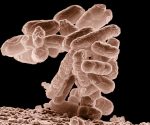Bacteria found at Rajgir hot spring shows antibacterial activity

To live a cozy life on the earth, a temperature of around 25° to 30° C is ideal. But during a heat wave, where temperatures can cross 40° C, the consequences can be deadly. Humans and most complex multicellular organisms are not built to tolerate such heat.
That doesn’t mean no living thing can, however.
Bacteria called thermophiles (meaning “heat lovers”) have been known to tolerate 45° to 70° C of heat. Such a high temperature can give human skin third-degree burns.

While such an environment may seem hellish to people, thermophilic bacteria see an opportunity. Places on the earth with temperatures like this — including hot springs, deep-sea thermal vents, and compost piles — offer a mineral-rich neighbourhood with relatively few competing life forms. To gain an edge, some thermophilic bacteria produce potent antibiotics as weapons to neutralise their competitors.
This is exactly why scientists have deemed hot springs around the world to be unexplored mines of antibiotic-producing bacteria. For example, thermophiles isolated from hot springs in the Asir and Jizan regions of Saudi Arabia have been found to produce a variety of potent antibiotics effective against gram-positive pathogenic bacteria.
The hot springs of India are not very well studied, however.
But driven by their putative value, researchers at the Vellore Institute of Technology (VIT) in Tamil Nadu examined the Rajgir hot spring lake in Nalanda district of Bihar. Their findings were published last month in the Indian Journal of Microbiology.
Exploring microbial diversity
“People take holy baths in these hot spring lakes, thinking diseases can be relieved,” K.V. Bhaskarrao, professor at VIT and corresponding author of the study paper, said. “As a microbiologist, I know that along with the elements that are present in the water, some of the microorganisms can also be responsible for this so-called curative activity.”
Studying which microbes are present in these hot spring lakes is challenging because researchers have to collect water and soil samples from a hot environment. At Rajgir, the temperature of the water can go up to 45° C, and the soil nearby can range between 43° and 45° C.
After collecting the samples, the researchers identified the microorganisms present in them, for which they used 16S rRNA metagenomics. This technique relies on identifying the 16S rRNA gene, which is found in all microbes but has slight variations across species, thus helping scientists to identify bacteria accurately.

Researchers found many species of bacteria but one group that particularly caught their attention was the Actinobacteria, which made up 40-43% of the microbial diversity at the lake. Bacteria belonging to this group are known producers of antimicrobial compounds. Well-known drugs like streptomycin and tetracycline were first discovered as the products of Actinobacteria.
“Hot springs studied till now showed very little diversity of Actinobacteria: — sometimes it is like 20% — but in our study I saw them to be abundant at Rajgir,” Aparana Kumari, a PhD scholar and first author of the study, said.
Discovering antibiotic-producing bacteria has become more pressing in the era of antimicrobial resistance — a silent epidemic fuelled by the unwarranted use of antibiotics. Bacteria have responded by developing ways to resist the drugs, reducing the latter’s potency. One outcome is the rising cost of healthcare, since multiple antibiotics may be required to treat a single infection. The World Health Organisation has projected antimicrobial resistance will add up to $1 trillion in healthcare costs worldwide by 2050.
Additionally, on average, pharmaceutical industries have been known to require a decade to bring novel antibiotics to the market whereas bacteria develop resistance in much less time.
Thus, the discovery of any bacterium that can produce a potent antibiotic against pathogens is considered good news. Not all thermophiles produce antibiotics, however, and to find out which ones do, the VIT researchers conducted an antibacterial efficiency experiment.
They cultured the prospective bacteria with different pathogenic strains: Escherichia coli, Salmonella typhimurium, Klebsiella pneumoniae, Pseudomonas aeruginosa, and Staphylococcus aureus. If the test bacteria could inhibit the growth of the pathogenic bacteria on a culture plate, it was confirmation that an antimicrobial compound was being produced.
In this way, the team was able to identify seven strains of Actinobacteria that produced potent antimicrobials against several pathogens.
Going a step further, researchers aimed to isolate the specific antibacterial compounds produced by these bacteria. In another paper published in Chemical Papers, an antibacterial compound was successfully extracted from a bacterium identified as Actinomycetales bacterium spp., obtained from the Rajgir hot spring. (While the Chemical Papers study was published before the Indian Journal Microbiology one, the work it describes came after.)
This bacterium produced a range of compounds. To isolate the one with antibacterial activity, the researchers used gas chromatography mass spectrometry, a sophisticated technique to separate compounds based on their chemical properties.
The compound was found to be diethyl phthalate and it inhibited the growth of Listeria monocytogenes, a pathogenic bacterium that causes listeriosis, a fatal foodborne infection. This finding suggests that diethyl phthalate could potentially be developed as a drug against L. monocytogenes infections.
Industrial, agricultural potential
The potential of thermophiles goes beyond antibiotics: they have many applications across industries. For example, the PCR test — widely in use during the COVID-19 pandemic to check for the virus’s presence — requires an enzyme that was first found in a thermophile called Thermus aquaticus.
A 2018 study in Frontiers in Microbiology by Banaras Hindu University researchers reported that a cocktail of bacteria from a hot spring in the Chumathang area of Leh district has the ability to promote plant growth. Associate professor and the study’s lead author Jay Prakash Verma said hot-spring strains are effective for industrial and agricultural applications thanks to their heat-tolerant properties.
Mohit Nikalje is an IISc alumnus and a science communicator based in Bengaluru.
Published – June 04, 2025 05:30 am IST















